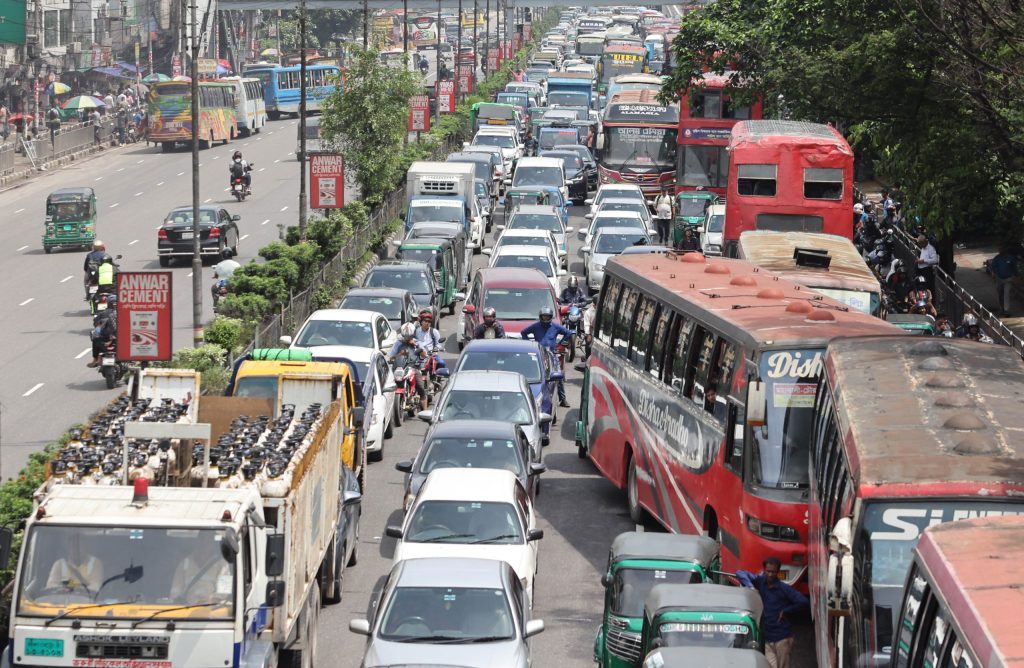Arefin Tanjib, Dhaka
To ease traffic pressure in Dhaka, diversions have been introduced at several major points, redirecting vehicles through alternative routes. But experts question how effective this temporary measure truly is.
Urban specialists note that, alongside the sheer number of vehicles, multiple speed categories on the same road, lack of lane discipline, railway crossings, and uncoordinated roadworks are all worsening traffic conditions. Diversions alone, they argue, cannot solve the crisis.
Mitul Ahmed, a resident of Mohammadpur who works at a private office in Tejgaon, described his ordeal: “Earlier, after office hours, I could easily return home using my bike through the Tejgaon–Bijoy Sarani flyover, crossing Urojahaj signal and entering Lake Road. But since 25 January, this easy journey is no longer possible. Now I must go through Mohakhali and Bijoy Sarani. Taking a U-turn near BG Press and then another near Farmgate is too much of a hassle. That’s why I prefer Mohakhali’s route now.”
Tejgaon Traffic Division’s Additional Deputy Commissioner (ADC) Tania Sultana told Times of Bangladesh: “We now see very few vehicles or bikes using the right lane via Tejgaon flyover. Mostly, those are residents of Mohammadpur or Dhanmondi. However, commuters no longer have to sit in long evening jams on the flyover as before.”
She added, “Our seven traffic divisions work in coordination to assess which area’s congestion affects Bijoy Sarani and vice versa. Some days traffic is heavy, some days it is lighter. Sometimes a section of road is closed, sometimes open. Special events also affect congestion. So, we adjust route maps daily and often make on-the-spot decisions to control traffic.”
Field-level officers, however, say handling the pressure of vehicles coming from Urojahaj Crossing via Bijoy Sarani remains a major challenge. With no alternative route, they are forced to hold vehicles until signals change, which in itself creates jams. They suggest that if a diversion towards Jahangir Gate could be arranged for left-turning vehicles, much of the pressure could be eased.

Road congestion is also pushing more people towards metro rail, creating long queues at Farmgate, Pallabi, and Mirpur stations. In August, simultaneous political rallies, HSC and BCS examinations, and the start of the working week paralysed the city.
At Farmgate station, commuter Asif Ali said: “Seeing the traffic, I opted for metro rail. But even here I had to stand in a long queue for tickets.”
Tejgaon Traffic Division reported that a new left lane near Bangladesh Eye Hospital at Dhanmondi 27 has improved traffic flow. Vehicles from Dhanmondi 27 (East) can now use the lane via Sat Masjid Road to reach Mohammadpur bus stand without stopping at signals. Previously they faced three signals; now only two. This has reduced congestion significantly in the area.
According to Dhaka Metropolitan Police (DMP), traffic officers work across 600 points in four shifts covering 24 hours. The first shift runs from 6:30am to 2:30pm, the second from 2:30pm to 10:30pm, the third from 10:30pm to 2:00am across 38 busy points, and the final shift from 2:00am to 6:30am at only nine key points.
These include Gabtoli, Shyamoli, Kalyanpur, Mohammadpur bus stand, Mohakhali bus terminal, Sayedabad, Jatrabari, Azampur, and Gulistan.
Md Shamsul Haque, professor at BUET’s Civil Engineering Department, told TIMES of Bangladesh: “The core reason for Dhaka’s unbearable traffic is the extremely low road density (only 2.52%). Meanwhile, 300–400 new vehicles are registered daily. Floating shops further reduce road space. Thus, diversions or U-turns cannot solve congestion.”
He stressed the need for structural reform: “If we could reorganise the road network, traffic could be reduced. Moreover, Dhaka’s surrounding rivers and waterbodies should be utilised. If water-launch services like Hatirjheel’s could be implemented, a significant portion of commuters would shift to waterways, as seen in Thailand. Yet, despite the opportunity, we are not using it.”
Calling for science-based and professional traffic management, he warned: “There is a lack of professionals. With superficial development projects, we have turned simple problems into complex ones.”
Tejgaon Traffic Division’s Deputy Commissioner (DC) Md Rafiqul Islam said: “With goodwill, coordinated planning, and firm steps, even limited resources can reduce traffic jams.”
He stressed the need for permanent road carpeting, proper median islands, and U-turns by the Roads and Highways Department and city corporations.
“Strict monitoring against illegal road occupation, regular city corporation cleaning, and respect for traffic laws by all can restore order,” he added.
Dhaka Transport Coordination Authority (DTCA) confirmed that meetings were recently held to improve intersection management, free up footpaths, ban illegal vehicles, regulate rickshaw operations block-wise, designate parking spaces, enhance signalling, and manage traffic during utility construction.
Experts conclude that while private initiatives can help, only government and relevant authorities hold the key to reducing Dhaka’s gridlock.


